Microsoft AZ-200 Exam Practice Questions (P. 2)
- Full Access (63 questions)
- Six months of Premium Access
- Access to one million comments
- Seamless ChatGPT Integration
- Ability to download PDF files
- Anki Flashcard files for revision
- No Captcha & No AdSense
- Advanced Exam Configuration
Question #6
DRAG DROP -
A company provides financial services. Core business solutions store data in an on-premises Microsoft SQL Server database. The solutions generate terabytes of data each year. The company stores data for at least seven years. Each year, the company has on average one instance where historical transaction data is needed.
You must migrate storage for the solution to the cloud. Data must be stored in an encrypted format and usable within 24 hours.
You need to select a storage technology for the solution that minimizes costs.
What should you implement? To answer, drag the appropriate technologies to the correct workloads. Each technology may be used once, more than once, or not at all. You may need to drag the split bar between panes or scroll to view content.
NOTE: Each correct selection is worth one point.
Select and Place:
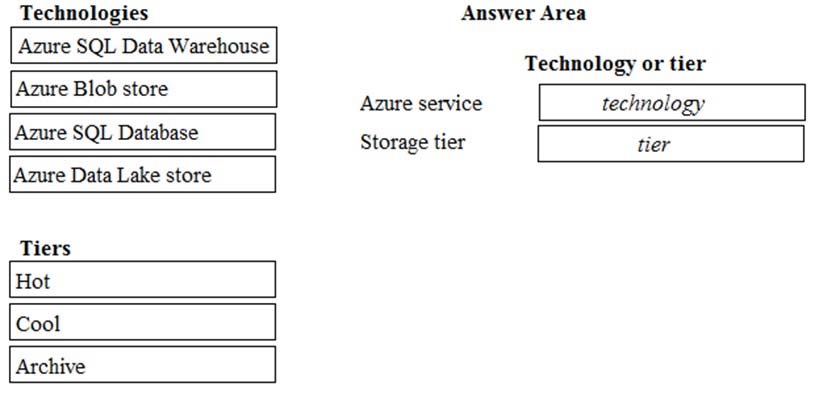
A company provides financial services. Core business solutions store data in an on-premises Microsoft SQL Server database. The solutions generate terabytes of data each year. The company stores data for at least seven years. Each year, the company has on average one instance where historical transaction data is needed.
You must migrate storage for the solution to the cloud. Data must be stored in an encrypted format and usable within 24 hours.
You need to select a storage technology for the solution that minimizes costs.
What should you implement? To answer, drag the appropriate technologies to the correct workloads. Each technology may be used once, more than once, or not at all. You may need to drag the split bar between panes or scroll to view content.
NOTE: Each correct selection is worth one point.
Select and Place:

Correct Answer:
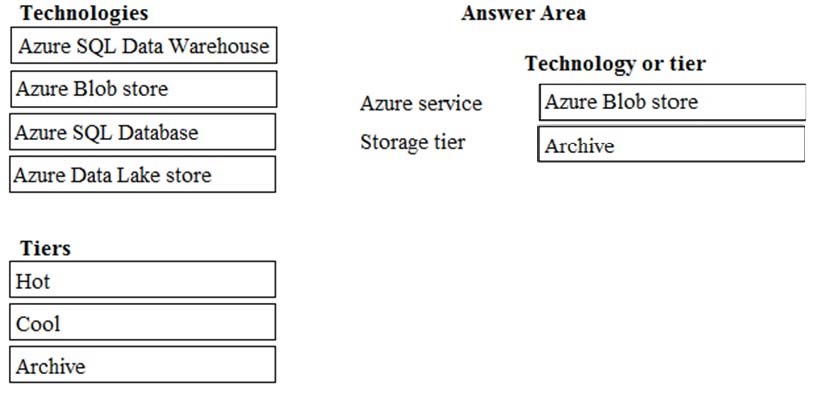
Box 1: Azure Blob store -
Azure storage offers different storage tiers which allow you to store Blob object data in the most cost-effective manner. The available tiers include:
✑ Premium storage (preview) provides high performance hardware for data that is accessed frequently.
✑ Hot storage: is optimized for storing data that is accessed frequently.
✑ Cool storage is optimized for storing data that is infrequently accessed and stored for at least 30 days.
✑ Archive storage
Box 2: Archive -
Archive storage is optimized for storing data that is rarely accessed and stored for at least 180 days with flexible latency requirements (on the order of hours).
References:
https://docs.microsoft.com/en-in/azure/storage/blobs/storage-blob-storage-tiers

Box 1: Azure Blob store -
Azure storage offers different storage tiers which allow you to store Blob object data in the most cost-effective manner. The available tiers include:
✑ Premium storage (preview) provides high performance hardware for data that is accessed frequently.
✑ Hot storage: is optimized for storing data that is accessed frequently.
✑ Cool storage is optimized for storing data that is infrequently accessed and stored for at least 30 days.
✑ Archive storage
Box 2: Archive -
Archive storage is optimized for storing data that is rarely accessed and stored for at least 180 days with flexible latency requirements (on the order of hours).
References:
https://docs.microsoft.com/en-in/azure/storage/blobs/storage-blob-storage-tiers
send
light_mode
delete
Question #7
HOTSPOT -
A company provides web app hosting services for customers.
You have a set of App Service Plans available to deploy resources for new projects. The available service tiers are shown in the Service Tiers exhibit. (Click the
Service Tiers tab.)
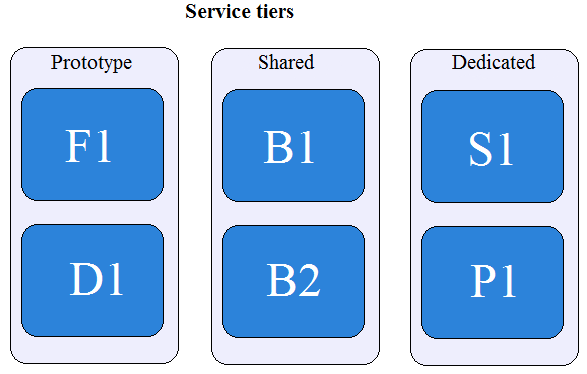
You must provision resources for the projects as shown in the Projects exhibit. (Click the Projects tab.)

The AdventureWorks project requires the use of deployment slots as shown in the Deployment Slots exhibit. (Click the Deployment Slots tab.)
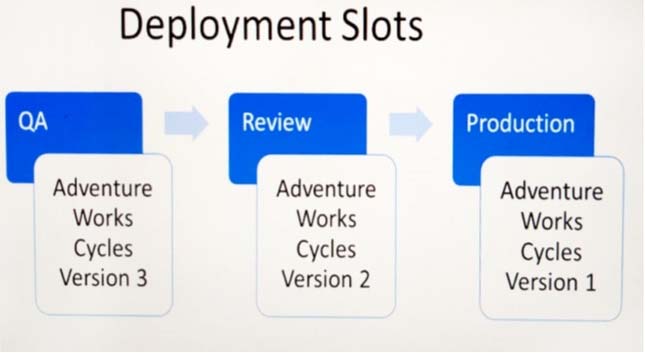
You need to determine where to deploy resources for each project.
For each of the following statements, select Yes if the statement is true. Otherwise, select No.
NOTE: Each correct selection is worth one point.
Hot Area:

A company provides web app hosting services for customers.
You have a set of App Service Plans available to deploy resources for new projects. The available service tiers are shown in the Service Tiers exhibit. (Click the
Service Tiers tab.)

You must provision resources for the projects as shown in the Projects exhibit. (Click the Projects tab.)

The AdventureWorks project requires the use of deployment slots as shown in the Deployment Slots exhibit. (Click the Deployment Slots tab.)

You need to determine where to deploy resources for each project.
For each of the following statements, select Yes if the statement is true. Otherwise, select No.
NOTE: Each correct selection is worth one point.
Hot Area:

Correct Answer:

Box 1: No -
AdventureWorks Cycles should use the dedicated service plan. The Dedicated service tier consists of S1 Standard instance, and the P1 premium instance.
Note: When you deploy your web app, web app on Linux, mobile back end, and API app to App Service, you can deploy to a separate deployment slot instead of the default production slot when running in the Standard, Premium, or Isolated App Service plan tier.
Box 2: Yes -
The prototype plan can be used for Research.
The Prototype Service consists F1 (free) instance, and D1 (shared instance)
Box 3: No -
Coho Vineyeard can be hosted on the Shared service tier.
The Shared service tier consists of the B1 and B2 basic instances.
References:
https://azure.microsoft.com/en-us/pricing/details/app-service/windows/

Box 1: No -
AdventureWorks Cycles should use the dedicated service plan. The Dedicated service tier consists of S1 Standard instance, and the P1 premium instance.
Note: When you deploy your web app, web app on Linux, mobile back end, and API app to App Service, you can deploy to a separate deployment slot instead of the default production slot when running in the Standard, Premium, or Isolated App Service plan tier.
Box 2: Yes -
The prototype plan can be used for Research.
The Prototype Service consists F1 (free) instance, and D1 (shared instance)
Box 3: No -
Coho Vineyeard can be hosted on the Shared service tier.
The Shared service tier consists of the B1 and B2 basic instances.
References:
https://azure.microsoft.com/en-us/pricing/details/app-service/windows/
send
light_mode
delete
Question #8
Each year, a company consolidates manufacturing data for a year and stores the data in a single blob within a Blob container. Data from previous years is stored in the same storage account in the same container.
The company has a General Purpose v2 (GPv2) Azure Storage account with a Blob container named Compliance-data. Data from previous years is retained for compliance reasons but it is infrequently accesses.
The current solution is becoming costly. You observe that users accidentally modify compliance data.
You need to reduce costs and preserve the compliance data.
What should you do?
The company has a General Purpose v2 (GPv2) Azure Storage account with a Blob container named Compliance-data. Data from previous years is retained for compliance reasons but it is infrequently accesses.
The current solution is becoming costly. You observe that users accidentally modify compliance data.
You need to reduce costs and preserve the compliance data.
What should you do?
- AIn the Azure Portal, go to configuration settings of each blob in the Compliance-data container and set Access tier to Archive.
- BSet up another GPv2 storage account and copy data to the new storage account.
- CIn the Azure Portal, go to configuration settings for each blob in the Compliance-data container and set the Access tier to Cool.
- DConfigure another GPv2 cold storage account and copy data to the new storage account.
Correct Answer:
C
Cool storage is optimized for storing data that is infrequently accessed and stored for at least 30 days.
Incorrect Answers:
A: Archive storage is optimized for storing data that is rarely accessed and stored for at least 180 days with flexible latency requirements (on the order of hours).
References:
https://docs.microsoft.com/en-in/azure/storage/blobs/storage-blob-storage-tiers
C
Cool storage is optimized for storing data that is infrequently accessed and stored for at least 30 days.
Incorrect Answers:
A: Archive storage is optimized for storing data that is rarely accessed and stored for at least 180 days with flexible latency requirements (on the order of hours).
References:
https://docs.microsoft.com/en-in/azure/storage/blobs/storage-blob-storage-tiers
send
light_mode
delete
Question #9
HOTSPOT -
A company is implementing a product that runs on Linux. They want to run the product in production in their on-premises datacenter and Azure.
The product must use the same technologies in Azure and on-premises with the most reliable and lowest latency connection.
You need to select the appropriate technologies.
Which technologies should you use? To answer, select the appropriate options in the answer area.
NOTE: Each correct selection is worth one point.
Hot Area:
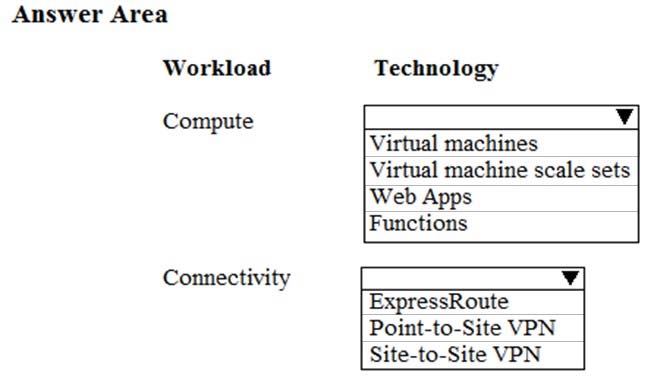
A company is implementing a product that runs on Linux. They want to run the product in production in their on-premises datacenter and Azure.
The product must use the same technologies in Azure and on-premises with the most reliable and lowest latency connection.
You need to select the appropriate technologies.
Which technologies should you use? To answer, select the appropriate options in the answer area.
NOTE: Each correct selection is worth one point.
Hot Area:

Correct Answer:
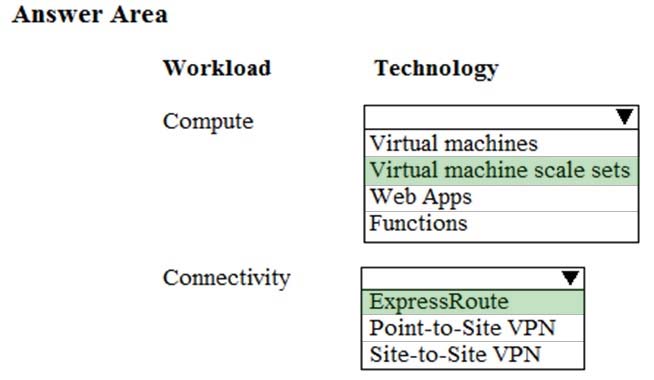
Box 1: Virtual machine scale sets
A virtual machine scale set allows you to deploy and manage a set of identical, auto-scaling virtual machines. You can scale the number of VMs in the scale set manually, or define rules to autoscale based on resource usage like CPU, memory demand, or network traffic. An Azure load balancer then distributes traffic to the
VM instances in the scale set.
You can deploy a scale set with a Windows Server image or Linux image such as RHEL, CentOS, Ubuntu, or SLES.
Box 2: ExpressRoute -
ExpressRoute is an Azure service that lets you create private connections between Microsoft datacenters and infrastructure that's on your premises or in a colocation facility. ExpressRoute connections do not go over the public Internet, and offer higher security, reliability, and speeds with lower latencies than typical connections over the Internet.
Incorrect Answers:
Not Web Apps:
Web App is a fully managed compute platform that is optimized for hosting websites and web applications. Customers can use App Service on Linux to host web apps natively on Linux for supported application stacks.
References:
https://docs.microsoft.com/en-us/azure/expressroute/expressroute-introduction https://docs.microsoft.com/en-us/azure/virtual-machine-scale-sets/quick-create-portal

Box 1: Virtual machine scale sets
A virtual machine scale set allows you to deploy and manage a set of identical, auto-scaling virtual machines. You can scale the number of VMs in the scale set manually, or define rules to autoscale based on resource usage like CPU, memory demand, or network traffic. An Azure load balancer then distributes traffic to the
VM instances in the scale set.
You can deploy a scale set with a Windows Server image or Linux image such as RHEL, CentOS, Ubuntu, or SLES.
Box 2: ExpressRoute -
ExpressRoute is an Azure service that lets you create private connections between Microsoft datacenters and infrastructure that's on your premises or in a colocation facility. ExpressRoute connections do not go over the public Internet, and offer higher security, reliability, and speeds with lower latencies than typical connections over the Internet.
Incorrect Answers:
Not Web Apps:
Web App is a fully managed compute platform that is optimized for hosting websites and web applications. Customers can use App Service on Linux to host web apps natively on Linux for supported application stacks.
References:
https://docs.microsoft.com/en-us/azure/expressroute/expressroute-introduction https://docs.microsoft.com/en-us/azure/virtual-machine-scale-sets/quick-create-portal
send
light_mode
delete
Question #10
You develop an application named App1 that needs to communicate with an existing app named MainApp. App1 is disconnected from other systems and uses different communication protocols than MainApp.
You must ensure that App1 is available in every Azure region and can be scaled out. App1 must be able to connect to MainApp across private and public cloud environments and process requests in the order they are received.
Which integration solution should you implement?
You must ensure that App1 is available in every Azure region and can be scaled out. App1 must be able to connect to MainApp across private and public cloud environments and process requests in the order they are received.
Which integration solution should you implement?
- AAzure Storage Queue
- BEvent Grid
- CAzure Relay
- DAzure Service Bus
Correct Answer:
A
References:
https://docs.microsoft.com/en-us/azure/service-bus-messaging/service-bus-azure-and-service-bus-queues-compared-contrasted
A
References:
https://docs.microsoft.com/en-us/azure/service-bus-messaging/service-bus-azure-and-service-bus-queues-compared-contrasted
send
light_mode
delete
All Pages
